财务管理·课后作业·习题班第10章
《财务管理》第十章
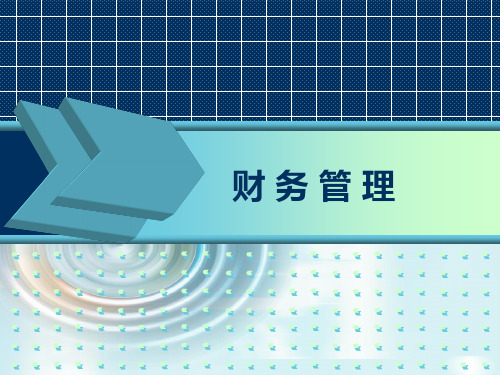
第一节 财务预算
2.财务预算是 企业各级各部门 工作协调的工具
企业内部各级各部门因其职责的不同,对各自经济活动的 考虑可能会带有片面性,甚至会出现相互冲突的现象。 克服片面、避免冲突的最佳办法是进行经济活动的综合平 衡。而财务预算具有高度的综合能力,编制财务预算的过 程也是企业内部各级各部门的经济活动密切配合、相互协 调、统筹兼顾、全面安排、搞好综合平衡的过程。
优点
预算期间与会计年度相匹配,便于将预算数和实际数 进行比照,有利于考核和评价预算的执行结果。
第一节 财务预算
缺点
〔1〕缺乏远期指导性 〔2〕造成预算滞后性 〔3〕形成人为的预算中断
第一节 财务预算
2.滚动预算
滚动预算又称连续预算或永续预算,是指在编制预算时,将预算期 与会计年度脱离,随着预算的执行不断修订并延伸预算,使预算期逐期 向后滚动,永远保持为一个固定期间长度的一种预算编制方法。
固定预算和弹性 预算
增量预算和零基 预算
定期预算和滚动 预算
第一节 财务预算
〔一〕固定预算和弹性预算
1.固定预算
固定预算又称静态预算,是指将预算期内的业务量固定在某一预计 水平上,并以此为根底来确定其他工程的预计数的预算方法。
缺点
① 过于机械呆板 ② 可比性差
第一节 财务预算
2.弹性预算
弹性预算又称变动预算,是指在本钱习性分析的根底上,以业务量 、本钱和利润之间的依存关系为依据,按照预算期可预见的各种业务量 水平,编制能够适应多种情况的预算方法。其关键是将所有的本钱分为 变动本钱和固定本钱两局部。
第二节 财务控制
〔二〕财务控制的根底
4.会计信息
(1)财务预算总目标的 执行情况必须通过企业的 汇总会计核算资料予以反 映。 (2)各责任中心财务预 算目标的执行情况也是通 过各自的会计核算资料予 以反映的,为考核各责任 中心的工作业绩和正确地 进行财务控制提供依据。
财务管理-第10章课件

二.右派理论 • 红利收入比资本收益更具有可测 性,因为公司管理层可以控制红利 却不能控制股价。对投资者来说, 红利就像囊中之物,其风险小于 资本收益。按风险与收益匹配的 原则,投资者对资本收益应要求 更高的回报率,即贴现率相应增 加。因此红利收入的现值会高于 等额的资本收益现值。
财务管理-第10章
2.信息传播论
• 这种理论的根源同不确定感消除论密切相关。 它认为红利给投资者传播了企业收益状况的 信息,或者反映了公司管理层有了改善经营 的决心。如果一个公司经营状况不十分理想, 它可能会实施稳定的低支付率股利政策。一 旦公司改变股利政策,提高股利支付率,投 资者会认为公司的财务状况已得以改善,或 者管理层下决心改善公司未来收益状况。红 利的提高传递了公司未来可能创造更多利润 的信息,这样的股票会吸引更多的投资者。 这一理论又被称为客户效应理论。客户效是 指企业股利策略的变动对股东的影响。
财务管理-第10章
二.左派理论
• 大多数经济学家和企业研究人员承认MM理 论是正确的.但现实世界的资本市场是不完 善的,也非完全有效的,如发行股票需要支付 成本,股票交易也要付出成本,政府对企业、 个人都要征税。因而MM理论在现实中出现 偏差。
• 有许多国家关于股利收入和资本增益的所 得税税率不一致。因而,左派理论以为: 无论何时,只要股利收入的税率高于资本 增益的税率,股东都会反对高红利政策, 公司应该支付较低的红利。剩余利润留在 公司内部,要么再投资,要么回购股票。
财务管理-第10章
9.3 股利政策
• 股利政策主要讨论税后利润的分配问题.主 要包括两个基本因素:
• 红利支付率(Payout Rate)。由于税后 利润=保留盈余+股利,保留盈余是筹资的重 要渠道,留存多少利润,支付多少股利是一个 矛盾 的两个方面。公司的最佳股利政策就 是能使这对矛盾得到解决,使公司的价值达 到最高。
财务会计学第10、1一、12章课后习题参考答案
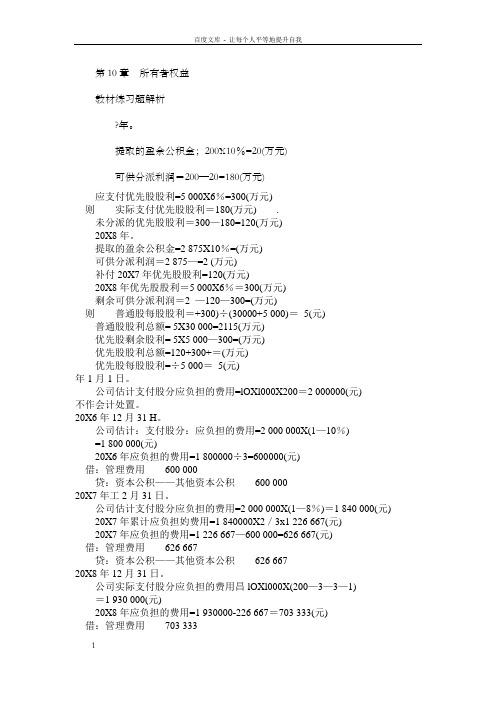
第10章所有者权益教材练习题解析?年。
提取的盈余公积金;200X10%=20(万元)可供分派利润=200—20=180(万元)应支付优先股股利=5 000X6%=300(万元)则实际支付优先股股利=180(万元) .未分派的优先股股利=300—180=120(万元)20X8年。
提取的盈余公积金=2 875X10%=(万元)可供分派利润=2 875—=2 (万元)补付20X7年优先股股利=120(万元)20X8年优先股股利=5 000X6%=300(万元)剩余可供分派利润=2 —120—300=(万元)则普通股每股股利=+300)÷(30000+5 000)=5(元)普通股股利总额= 5X30 000=2115(万元)优先股剩余股利= 5X5 000—300=(万元)优先股股利总额=120+300+=(万元)优先股每股股利=÷5 000=5(元)年1月1日。
公司估计支付股分应负担的费用=lOXl000X200=2 000000(元)不作会计处置。
20X6年12月31 H。
公司估计:支付股分:应负担的费用=2 000 000X(1—10%)=1 800 000(元)20X6年应负担的费用=1 800000÷3=600000(元)借:管理费用600 000贷:资本公积——其他资本公积600 00020X7年工2月31日。
公司估计支付股分应负担的费用=2 000 000X(1—8%)=1 840 000(元) 20X7年累计应负担妁费用=1 840000X2/3x1 226 667(元)20X7年应负担的费用=1 226 667—600 000=626 667(元)借:管理费用626 667贷:资本公积——其他资本公积626 66720X8年12月31日。
公司实际支付股分应负担的费用昌lOXl000X(200—3—3—1)=1 930 000(元)20X8年应负担的费用=1 930000-226 667=703 333(元)借:管理费用703 333贷:资本公积——其他资本公积703 33320X9年1月1日。
公司财务管理第10章_资本成本(参考答案)

第10章资本成本(习题参考答案)一、简答题(参考答案)1.从企业管理者筹集资金的角度来看,资本成本是企业筹集和使用资金而付出的代价;从投资者的角度理解,资本成本是资金提供者(债权人或股东)要求得到的投资报酬率。
资本成本与“投资者要求的报酬率”是同一问题的两个方面。
考虑筹资决策时,强调资本成本;考虑投资决策时,强调投资者收益率。
筹资者的资金来源于投资者的投资,若企业(项目)的收益率达不到投资者要求的报酬率,投资者将不会对企业(项目)进行投资,筹资者也就筹集不到所需的资金。
因此,资本成本的高低实质上是由投资者的必要报酬率决定的。
但由于债务利息抵税差异及筹资费用等因素的存在,资本成本与投资者要求的报酬率并不完全相等。
2.表面上看,留存收益来自企业的税后利润,取得留存收益不用支付筹资费用,使用留存收益也不需要付出利息、股利等成本。
但实际上,对于股东来说,留存于企业的利润是其放弃获得的现金股利。
股东愿意放弃享受现金股利的权利,而将其留用于企业,就相当于对企业进行追加投资。
股东对这部分资金也是要求获得与普通股等同的报酬的,以弥补其承受的机会成本。
因此,留存收益的资本成本和普通股一样,都是股东要求的必要报酬率。
3.①股利贴现法原理简单,只需要知道当前股利、股票价格及未来股利增长率。
但是实践中较难准确估计未来现金股利的增长率,如果未来股利不以固定增长率增长,还需根据分阶段的股利贴现模型进行计算,计算过程较为复杂。
②资本资产定价模型法逻辑严密合理,理论性强;且不需要对现金股利增长率做假设,即使企业没有分派红利也可应用此模型,适用范围广。
但β系数难以确定,一般投资者很难有条件做出估算。
③风险溢价法计算简便,只需估算债务资本成本。
但要求的风险溢价是基于所有公司的一个平均值,估计时带有一定的主观色彩,不如CAPM模型对单个公司风险溢价进行估计的方法精确。
4.单项资本在资本总额中权重的确定可能依据账面价值、市场价值和目标资本结构。
财务管理课后习题答案(完美版)
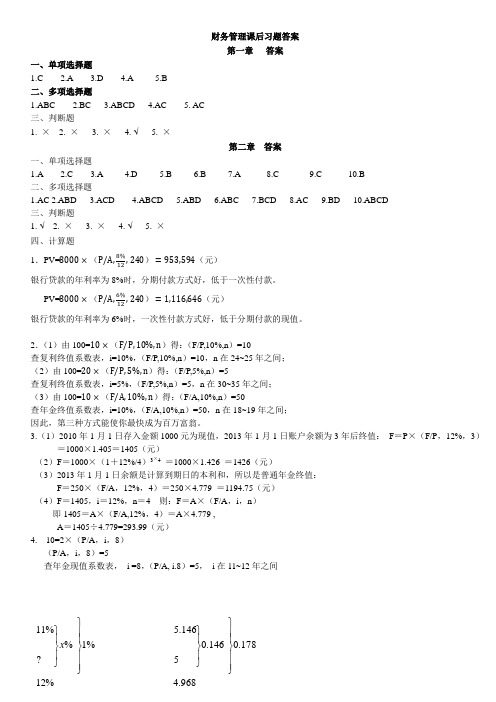
财务管理课后习题答案第一章 答案一、单项选择题1.C2.A3.D4.A5.B 二、多项选择题1.ABC2.BC3.ABCD4.AC5. AC 三、判断题1. ×2. ×3. ×4. √5. ×第二章 答案一、单项选择题1.A2.C3.A4.D5.B6.B7.A8.C9.C 10.B 二、多项选择题1.AC2.ABD3.ACD4.ABCD5.ABD6.ABC7.BCD8.AC9.BD 10.ABCD 三、判断题1. √2. ×3. ×4. √5. × 四、计算题1.PV=8000×(P/A,8%12,240)=953,594(元)银行贷款的年利率为8%时,分期付款方式好,低于一次性付款。
PV=8000×(P/A,6%12,240)=1,116,646(元)银行贷款的年利率为6%时,一次性付款方式好,低于分期付款的现值。
2.(1)由100=10×(F/P,10%,n )得:(F/P,10%,n )=10 查复利终值系数表,i=10%,(F/P,10%,n )=10,n 在24~25年之间; (2)由100=20×(F/P,5%,n )得:(F/P,5%,n )=5 查复利终值系数表,i=5%,(F/P,5%,n )=5,n 在30~35年之间;(3)由100=10×(F/A,10%,n )得:(F/A,10%,n )=50 查年金终值系数表,i=10%,(F/A,10%,n )=50,n 在18~19年之间; 因此,第三种方式能使你最快成为百万富翁。
3.(1)2010年1月1日存入金额1000元为现值,2013年1月1日账户余额为3年后终值: F =P ×(F/P ,12%,3)=1000×1.405=1405(元)(2)F =1000×(1+12%/4)3×4 =1000×1.426 =1426(元)(3)2013年1月1日余额是计算到期日的本利和,所以是普通年金终值:F =250×(F/A ,12%,4)=250×4.779 =1194.75(元) (4)F =1405,i =12%,n =4 则:F =A ×(F/A ,i ,n ) 即1405=A ×(F/A,12%,4)=A ×4.779 ,A =1405÷4.779=293.99(元) 4. 10=2×(P/A ,i ,8) (P/A ,i ,8)=5查年金现值系数表, i =8,(P/A, i.8)=5, i 在11~12年之间178.0146.0146.5%1%%11⎪⎪⎫⎪⎫⎪⎪⎫⎪⎫x2021 得,借款利率为11.82%5.递延年金现值P =300×(P/A ,10%,5)×(P/F ,10%,2)=300×3.791×0.826=939.4098(万元)。
财务管理(清华大学出版社 第2版)习题答案(共16页)

第1章财务管理总论【题1—1】〔1〕无限责任即467 000元;〔2〕因为600 000-36 000=564 000>467 000,即洪亮仍需承当467 000元,合伙人没有承当风险;〔3〕有限责任即263 000-90 000=173 000元。
【题1—2】〔1〕假设公司经营的产品增值率低那么应争取一般纳税人,否那么是小规模纳税人;〔2〕理论上的征收率=[增值额/销售收入]×增值税率,假设大于实际征收率应选择小规模纳税人,假设小于那么应选择一般纳税人,假设相等是没有区别的。
【题1—3】25.92%【题1—4】应积极筹集资金回购债券。
第2章财务管理根本价值观念【题2—1】〔1〕计算该项改扩建工程的总投资额:2000×〔F/A,12%,3〕=2000×3.3744=6748.80〔万元〕从以上计算的结果说明该矿业公司连续三年的投资总额为6748.80万元。
〔2〕计算该公司在7年内等额归还银行全部借款的本息的金额:÷÷4.5638=1478.77〔万元〕计算结果说明,该项工程完工后,该矿业公司假设分7年等额归还全部贷款的本息,那么每年末应偿付1478.77万元。
〔3〕计算该公司以每年的净利和折旧1800万元归还银行借款,需要多少年才能还清本息。
÷查1元年金现值表,在12%这一栏内找出与3.7493相邻的两个年金现值系数及其相应的期数,并采用插值法计算如下:以上计算结果说明,该公司如果每年末用1800万元来归还贷款的全部本息,需要5.29年可还清。
【题2—2】10年收益于2003年年初的现值为:800000×〔P/A,6%,10〕×〔P/F,6%,5〕=800000××0.7473=4400162〔元〕或:800000×〔P/A,6%,15〕-800000×〔P/A,6%,5〕 =800000××4.2124=4399840〔元〕【题2—3】P=3×〔P/A, 6%, 6〕=3×4.9173=14.7915〔万元〕宋女士付给甲开发商的资金现值为:10+14.7915= 24.7915 〔万元〕如果直接按每平方米2000元购置,宋女士只需要付出20万元,由此可见分期付款对她而言不合算。
《财务管理学》(人大版)第十章习题答案

第10章短期筹资管理一、名词解释1、短期筹资2、信用借款3、循环协议借款4、票据贴现5、商业信用6、信用额度7、担保借款8、应用账款余额百分比9、质押借款 10、短期融资券二、判断题1.信用额度是指商业银行和企业之间商定的在未来一段时间内银行必须向企业提供的无担保贷款()2.循环协议借款是一种特殊的信用额度借款、企业和银行要协商确定贷款的最高限额,在最高限额内,企业可以借款、还款,再借款、再还款,不停地周转使用。
()3.信用额度借款和循环协议借款的有效期一般为1年。
()4. 循环协议贷款不具有法律约束力,不构成银行必须给企业提供贷款的法律责任,而信用额度贷款具有法律约束力,银行要承担额度内的贷款义务。
()5. 企业采用循环协议借款,除支付利息外,还要支付协议费,而在信用额度借款的情况下,一般无须支付协议费。
( )6. 质押借款是指按《中华人民共和国担保法》规定的质押方式,以借款人或第三人的不动产或权利作为质押物而取得。
()7. 票据贴现是银行信用发展的产物,实为一种商业信用。
()8.贴现率是指贴现息与贴现金额的比率。
()9. 商业信用是指商品交易中的延期付款或延期交货所形成的借贷关系,是企业之间的一种直接信用关系。
()10. 赊购商品和预付货款是商业信用融资的两种典型形式。
()11. 商业信用筹资的优点是使用方便、成本低、限制少、缺点是时间短。
()12.应付费用所筹集的资金不用支付任何代价,是一项免费的短期资金来源,因此可以无限制地加以利用。
()13. 银行短期借款的优点是具有较好的弹性,缺点是资金成本较高,限制较多。
()14. 由于丧失现金折扣的机会成本很高,所以购买单位应该尽量争取获得此项折扣。
()15. 利用商业信用融资的限制较多,而利用银行信用融资的限制较少。
()16.直接销售的融资券是指发行人直接销售给最终投资者的融资券。
()17. 金融企业的融资券一般都采用间接发行形式。
()18. 目前我国短期融资券的利率一般要比银行借款利率高,这是因为短期融资券的成本比较高。
财务管理第十章短期筹资管理课后习题+答案
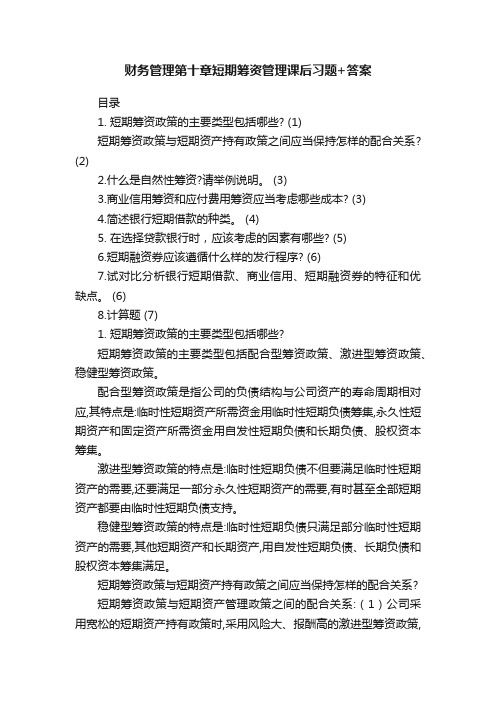
财务管理第十章短期筹资管理课后习题+答案目录1. 短期筹资政策的主要类型包括哪些? (1)短期筹资政策与短期资产持有政策之间应当保持怎样的配合关系?(2)2.什么是自然性筹资?请举例说明。
(3)3.商业信用筹资和应付费用筹资应当考虑哪些成本? (3)4.简述银行短期借款的种类。
(4)5. 在选择贷款银行时,应该考虑的因素有哪些? (5)6.短期融资券应该遵循什么样的发行程序? (6)7.试对比分析银行短期借款、商业信用、短期融资券的特征和优缺点。
(6)8.计算题 (7)1. 短期筹资政策的主要类型包括哪些?短期筹资政策的主要类型包括配合型筹资政策、激进型筹资政策、稳健型筹资政策。
配合型筹资政策是指公司的负债结构与公司资产的寿命周期相对应,其特点是:临时性短期资产所需资金用临时性短期负债筹集,永久性短期资产和固定资产所需资金用自发性短期负债和长期负债、股权资本筹集。
激进型筹资政策的特点是:临时性短期负债不但要满足临时性短期资产的需要,还要满足一部分永久性短期资产的需要,有时甚至全部短期资产都要由临时性短期负债支持。
稳健型筹资政策的特点是:临时性短期负债只满足部分临时性短期资产的需要,其他短期资产和长期资产,用自发性短期负债、长期负债和股权资本筹集满足。
短期筹资政策与短期资产持有政策之间应当保持怎样的配合关系?短期筹资政策与短期资产管理政策之间的配合关系:(1)公司采用宽松的短期资产持有政策时,采用风险大、报酬高的激进型筹资政策,用大量短期负债筹资,可以在一定程度上平衡公司持有过多短期资产带来的低风险、低报酬,使公司总体的报酬和风险基本均衡。
(2)公司采用适中的短期资产持有政策时,采用风险和报酬居中的配合型筹资政策,与适中的持有政策匹配,则会使公司总体的风险和报酬处于一个平均水平;采用激进型的筹资政策,则增加了公司的风险和报酬水平;采用稳健型的筹资政策,则降低了公司的风险和报酬水平。
(3)公司采用紧缩的短期资产持有政策时,与风险小、报酬低的稳健型筹资政策配合,可以对紧缩的持有政策产生平衡效应。
《财务管理第十章》PPT课件课件

短缺成本是指因置存货币资金太少而给企业造 成的损失。
管理成本是指企业因置存货币资金而发生的管 理费用。
《财务管理第十章》PPT课件
5
(四)现金管理的目的
3.现金管理的目标
目标1—流动性
必须持有足够的现金以便 支
付各种业务往来的需要。
权衡 目标2—收益性
相关总成本达最小值 TC* 2bTi
《财务管理第十章》PPT课件
15
确定现金余额的存货模式
现 金 余 额 N
N /2
t1 t2 t 3
时间
《财务管理第十章》PPT课件
16
成 本
总成 TC 本 N•iT•b 2N
持有成本 N•i 2
最佳现金余额N
转换成本 T •b N
现金持有数量
总成 TC 本 N•iT•b,N 对 求导数,并 为令 零一 N ˆ, 阶 2T 得 b导数
20
例:某企业1998年平均占用现金1000万, 50万为不合理占用,1999年销售收入预 计交1998年增长10%,则1999年最佳现 金余最 额?佳现金余额为:
(100050)(110%)104(5万)
《财务管理第十章》PPT课件
21
四、现金的日常控制
(一)加速收款
支票邮寄时间和停留时间与客户、公司、分行之间的距
8
编制现金 收支计划
企业现金 收支数量
进行现金 日常控制
当现金短缺时采 用短期融资策略
确定最佳 现金余额
当现金多余时采用还 款或有价证券投资策略
《财务管理第十章》PPT课件
9
二、现金收支计划的编制
(一)现金收入 1、营业现金收入;2、其他现金收入。
财务管理课后答案第十章
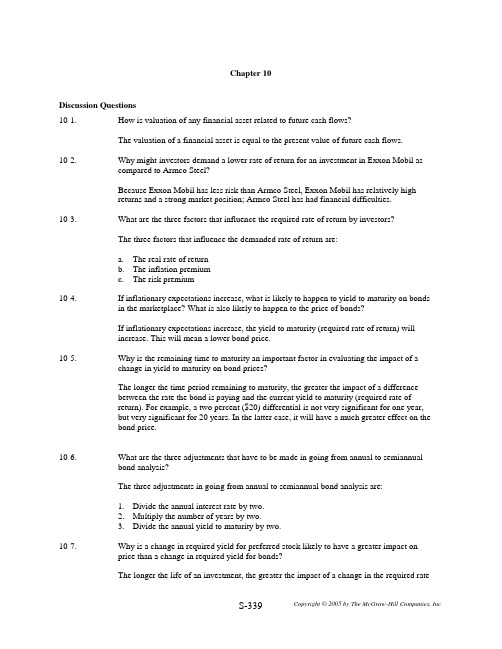
Chapter 10Discussion Questions10-1. How is valuation of any financial asset related to future cash flows?The valuation of a financial asset is equal to the present value of future cash flows.10-2. Why might investors demand a lower rate of return for an investment in Exxon Mobil as compared to Armco Steel?Because Exxon Mobil has less risk than Armco Steel, Exxon Mobil has relatively highreturns and a strong market position; Armco Steel has had financial difficulties.10-3. What are the three factors that influence the required rate of return by investors?The three factors that influence the demanded rate of return are:a.The real rate of returnb.The inflation premiumc.The risk premium10-4. If inflationary expectations increase, what is likely to happen to yield to maturity on bonds in the marketplace? What is also likely to happen to the price of bonds?If inflationary expectations increase, the yield to maturity (required rate of return) willincrease. This will mean a lower bond price.10-5. Why is the remaining time to maturity an important factor in evaluating the impact of a change in yield to maturity on bond prices?The longer the time period remaining to maturity, the greater the impact of a differencebetween the rate the bond is paying and the current yield to maturity (required rate ofreturn). For example, a two percent ($20) differential is not very significant for one year,but very significant for 20 years. In the latter case, it will have a much greater effect on thebond price.10-6. What are the three adjustments that have to be made in going from annual to semiannual bond analysis?The three adjustments in going from annual to semiannual bond analysis are:1.Divide the annual interest rate by two.2.Multiply the number of years by two.3.Divide the annual yield to maturity by two.10-7. Why is a change in required yield for preferred stock likely to have a greater impact on price than a change in required yield for bonds?The longer the life of an investment, the greater the impact of a change in the required rateof return. Since preferred stock has a perpetual life, the impact is likely to be at a maximum.10-8.What type of dividend pattern for common stock is similar to the dividend payment for preferred stock?The no-growth pattern for common stock is similar to the dividend on preferred stock.10-9.What two conditions must be met to go from Formula 10-8 to Formula 10-9 in using the dividend valuation model?()910g-K D P e 10-=To go from Formula (10-8) to Formula (10-9):The firm must have a constant growth rate (g).The discount rate (k e ) must exceed the growth rate (g).10-10.What two components make up the required rate of return on common stock?The two components that make up the required return on common stock are:a. The dividend yield D 1/P o .b. The growth rate (g). This actually represents the anticipated growth in dividends,earnings, and stock price over the long term.10-11.What factors might influence a firm's price-earnings ratio?The price-earnings ratio is influenced by the earnings and sales growth of the firm, the risk (or volatility in performance), the debt-equity structure of the firm, the dividend policy, the quality of management, and a number of other factors. Firms that have bright expectations for the future tend to trade at high P/E ratios while the opposite is true of low P/E firms.10-12.How is the supernormal growth pattern likely to vary from the normal, constant growth pattern?A supernormal growth pattern is represented by very rapid growth in the early years of a company or industry that eventually levels off to more normal growth. The supernormal growth pattern is often experienced by firms in emerging industries, such as in the early days of electronics or microcomputers.10-13.What approaches can be taken in valuing a firm's stock when there is no cash dividend payment?In valuing a firm with no cash dividend, one approach is to assume that at some point in the future a cash dividend will be paid. You can then take the present value of future cash dividends.A second approach is to take the present value of future earnings as well as a futureanticipated stock price. The discount rate applied to future earnings is generally higher thanthe discount rate applied to future dividends.Problems(For the first nine bond problems, assume interest payments are on an annual basis.)10-1. Burns Fire and Casualty Company has $1,000 par value bonds outstanding at 11 percent interest. The bonds will mature in 20 years. Compute the current price of the bonds if thepresent yield to maturity is:a. 6 percent.b. 8 percent.c. 12 percent.Solution:Burns Fire and Casualty Companya. 6 percent yield to maturityPresent Value of Interest PaymentsPV A = A x PV IFA (n = 20, i = 6%) Appendix D PV A = $110 x 11.470 = $1,261.70Present Value of Principal Payment at MaturityPV = FV x FV IF (n = 20, i = 6%) Appendix B PV = 1,000 x .312 = $312Present Value of Interest Payment $1,261.70 Present Value of Principal Payment 312.00 Total Present Value or Price of the Bond $1,573.70 10-1. Continuedb. 8 percent yield to maturityPV A = A x PV IFA (n = 20, i = 8%) Appendix D PV A = $110 x 9.818 = $1,079.98PV = FV x PV IF (n = 20, i = 8%) Appendix B PV = $1,000 x .215 = $215$1,079.98215.00$1,294,88 c. 12 percent yield to maturityPV A = A x PV IFA (n = 20, i = 12%) Appendix D PV A = $110 x 7.469 = $821.59PV = FV x PV IF (n = 20, i = 12%) Appendix B PV = $1,000 x .104 = $104$821.59104.00$925.59 10-2. Midland Oil has $1,000 par value bonds outstanding at 8 percent interest. The bonds will mature in 25 years. Compute the current price of the bonds if the present yield to maturityis:a. 7 percent.b. 10 percent.c. 13 percent.Solution:Midland Oila. 7 percent yield to maturityPresent Value of Interest PaymentsPV A = A x PV IFA (n = 25, i = 7%) Appendix D PV A = $80 x 11.654 = $932.32Present Value of Principal Payment at MaturityPV = FV x PV IF (n = 25, i = 7%) Appendix BPV = $1,000 x .184 = $184Total Present ValuePresent Value of Interest Payments $ 932.32 Present Value of Principal Payments 184.00 Total Present Value or Price of the Bond $1,116.32 b. 10 percent yield to maturityPV A = A x PV IFA (n = 25, i = 10%) Appendix D PV A = $80 x 9.077 = $726.16PV = FV x PV IF (n = 25, i = 10%) Appendix B PV = $1,000 x .092 = $92$726.1692.00$818.16 10-2. Continuedc. 13 percent yield to maturityPV A = A x PV IFA (n = 25, i = 13%) Appendix D PV A = $80 x 7.330 = $586.40PV = FV x PV IF (n = 25, i = 13%) Appendix B PV = $1,000 x .047 = $47$586.4047.00$633.4010-3. Exodus Limousine Company has $1,000 par value bonds outstanding at 10 percent interest.The bonds will mature in 50 years. Compute the current price of the bonds if the percentyield to maturity is:a. 5 percent.b. 15 percent.Solution:Exodus Limousine Companya. 5 percent yield to maturityPresent Value of Interest PaymentsPV A = A x PV IFA (n = 50, i = 5%) Appendix D PV A = $100 x 18.256 = $1,825.60Present Value of Principal PaymentPV = FV x PV IF (n = 50, i = 5%) Appendix B PV = $1,000 x .087 = $87Present Value of Interest Payment $1,825.60 Present Value of Principal Payment 87.00 Total Present Value or Price of the Bond $1,912.6010-3. Continuedb. 15 percent yield to maturityPresent Value of Interest PaymentsPV A = A x PV IFA (n = 50, i = 15%) Appendix D PV A = $1,000 x 6.661 = $666.10PV = FV x PV IF (n = 50, i = 15%) Appendix B PV = $1,000 x .001 = $1Present Value of Interest Payment $666.10 Present Value of Principal Payment 1.00 Total Present Value or Price of the Bond $667.10 10-4. Harrison Ford Auto Company has a $1,000 par value bond outstanding that pays 11 percent interest. The current yield to maturity on each bond in the market is 8 percent.Compute the price of these bonds for these maturity dates:a. 30 years.b. 15 years.c. 1 year.Solution:Harrison Ford Auto Companya. 30 years to maturityPresent Value of Interest PaymentsPV A = A x PV IFA (n = 30, i = 8%) Appendix DPV A = $110 x 11.258 = $1,238.38Present Value of Principal PaymentPV = FV x PV IF (n = 30, i = 8%) Appendix B PV = $1,000 x .099 = $9910-4. ContinuedTotal Present ValuePresent Value of Interest Payment $1,238.38 Present Value of Principal Payment 99.00 Total Present Value or Price of the Bond $1,337.38 b. 15 years to maturityPV A = A x PV IFA (n = 15, i = 8%) Appendix D PV A = $110 x 8.559 = $941.49PV = FV x PV IF (n = 15, i = 8%) Appendix B PV = $1,000 x .315 = $315$ 941.49315.00$1,256.49 c. 1 year to maturityPV A = A x PV IFA (n = 1, i = 8%) Appendix D PV A = $110 x .926 = $101.86PV = FV x PV IF (n = 1, i = 8%) Appendix B PV = $1,000 x .926 = $926.00$ 101.86926.00$1,027.86 10-5. Kilgore Natural Gas has a $1,000 par value bond outstanding that pays 9 percent annual interest. The current yield to maturity on such bonds in the market is 12 percent. Computethe price of the bonds for these maturity dates:a. 30 years.b. 15 years.c. 1 year.Solution:Kilgore Natural Gasa. 30 years to maturityPresent Value of Interest PaymentsPV A = A x PV IFA (n = 30, i = 12%) Appendix D PV A = $90 x 8.055 = $724.95PV = FV x PV IF (n = 30, i = 12%) Appendix B PV = $1,000 x .033 = $33Total Present ValuePresent Value of Interest Payments $724.95 Present Value of Principal Payment 33.00 Total Present Value or Price of the Bond $757.95b. 15 years to maturityPV A = A x PV IFA (n = 15, i = 12%) Appendix D PV A = $90 x 6.811 = $612.99PV = FV x PV IF (n = 15, i = 12%) Appendix B PV = $1,000 x .183 = $183 $612.99 183.00 $795.9910-5. Continuedc. 1 year to maturity PV A = A x PV IFA Appendix D PV A = $90 x .893 = $80.37PV = FV x PV IF Appendix B PV = $1,000 x .893 = $893.00 $ 80.37 893.00 $973.37 10-6. For Problem 5 graph the relationship in a manner similar to the bottom half. of Figure 10-2.Also explain why the pattern of price change occurs.Solution:Kilgore Natural Gas (Continued)30 25 15 5 0$1,000 Years10-7.Go to Table 10-1 which is based on bonds paying 10 percent interest for 20 years. Assume interest rates in the market (yield to maturity) decline from 11 percent to 8 percent:a. What is the bond price at 11 percent?b. What is the bond price at 8 percent?c. What would be your percentage return on investment if you bought when rates were 11percent and sold when rates were 8 percent?Solution:a. $920.30b. $1,196.80c. Sales price (8%) $1,196.80 Purchase price (11%) 920.30 Profit $ 276.50%04.3030.920$50.276$Price Purchase Profit ==10-8.Using Table 10-2:a. Assume the interest rate in the market (yield to maturity) goes down to 8 percent forthe 10 percent bonds. Using column 2, indicate what the bond price will be with a 5-year, a 15-year, and a 30-year time period.b. Assume the interest rate in the market (yield to maturity) goes up to 12 percent for the10 percent bonds. Using column 3, indicate what the bond price will be with a 5-year, a 10-year, and a 30-year period.c. Based on the information in part a , if you think interest rates in the market are goingdown, which bond would you choose to own?d. Based on information in part b , if you think interest rates in the market are going up,which bond would you choose to own?Solution: a.MaturityBond price 5 year $1,080.30 15 year 1,170.9030 year1,224.80b. . MaturityBond price 5 year 927.50 15 year 864.11 30 year 838.50c. Based on information in Part a, you would want to own the longest-term bond possible to maximizeyour gain.d. Based on information in Part b, you would want to own the shortest-term bond possible to minimizeyour loss.10-9. Jim Busby calls his broker to inquire about purchasing a bond of Disk Storage Systems.His broker quotes a price of $1,180. Jim is concerned that the bond might be overpricedbased on the facts involved. The $1,000 par value bond pays 14 percent interest, and it has25 years remaining until maturity. The current yield to maturity on similar bonds is 12percent. Compute the new price of the bond and comment on whether you think it isoverpriced in the marketplace.Solution:Jim Busby – Disk Storage SystemsPresent Value of Interest PaymentsPV A = A x PV IFA (n = 25, i = 12%) Appendix D PV A = $140 x 7.843 = $1,098.02Present Value of Principal Payment at MaturityPV = FV x PV IF (n = 25, i = 12%) Appendix B PV = $1,000 x .059 = $59$1,098.0259.00$1,157.02 The bond has a value of $1,157.02. This indicates his broker is quoting too high a price at $1,180.10-10. Tom Cruise Lines, Inc., issued bonds five years ago at $1,000 per bond. These bonds had a 25-year life when issued and the annual interest payment was then 12 percent. This returnwas in line with the required returns by bondholders at that point as described below:Real rate of return .................................................... 3%Inflation premium (5)Risk premium (4)Total return ............................................................ 12%Assume that five years later the inflation premium is only 3 percent and is appropriatelyreflected in the required return (or yield to maturity) of the bonds. The bonds have 20 yearsremaining until maturity.Compute the new price of the bond.Solution:Tom Cruise Lines, Inc.First compute the new required rate of return (yield to maturity).Real rate of return 3%Inflation premium 3Risk premium 4Total return 10%Then use this value to find the price of the bond.Present Value of Interest PaymentsPV A = A x PV IFA (n = 20, i = 10%) Appendix D PV A = $120 x 8.514 = $1,021.68Present Value of Principal Payment at MaturityPV = FV x PV IF (n = 20, i = 10%) Appendix B PV = $1,000 x .149 = $149$1,021.68149.00$1,170.68 10-11. Further analysis of problem 10:a. Find the present value of 2 percent x $1,000 (or $20) for 20 years at 10 percent. The$20 is assumed to be an annual payment.b. Add this value to $1,000.c. Explain why the answers to problem 11b and problem 10 are basically the same.(There is a slight difference due to rounding in the tables.)Solution:Further Analysis of Problem 10a. PV A = A x PV IFA (n = 20, i = 10%) Appendix DPV A = $20 x 8.514 = $170.28b. $1,000.00170.28$1,170.28c. The answer to problem 11b of $1,170.28 and problem 10 of $1,170.68 are basically the same because inboth cases we are valuing the present value of a $20 differential between actual return and required return for 20 years.In problem 11b we take the present value of the $20 differential to arrive at $170.28. We then add this value to the $1,000.00 par value to determine a value of $1,170.28.In problem 10, we accomplish the same goal by valuing all future benefits at a two percent differential between actual return and required return to arrive at $1,170.68.10-12. Wilson Oil Company issued bonds five years ago at $1,000 per bond. These bonds had a 25 year life when issued and the annual interest payment was then 8 percent. This return was inline with the required returns by bondholders at that point in time as described below:Real rate of return .................................................... 2%Inflation premium (3)Risk premium (3)Total return ............................................................ 8%Assume that 10 years later, due to bad publicity, the risk premium is now 6 percent and isappropriately reflected in the required return (or yield to maturity) of the bonds. The bondshave 15 years remaining until maturity. Compute the new price of the bond.Solution:Wilson Oil CompanyFirst compute the new required rate of return (yield to maturity).Real rate of return 2% Inflation premium 3% Risk premium 6% 11% total required returnThen use this value to find the price of the bond.Present Value of Interest Payments PV A = A x PV IFA (n = 15, i = 11%) Appendix D PV A = $80 x 7.191 = $575.28Present Value of Principal Payment at Maturity PV = FV x PV IF (n = 15, i = 11%) Appendix B PV = $1,000 x .209 = $209.00 $575.28 209.00 Bond Price = $784.2810-13. Bonds issued by the Crane Optical Company have a par value of $1,000, which is also theamount of principal to be paid at maturity. The bonds are currently selling for $850. They have 10 years remaining to maturity. The annual interest payment is 9 percent ($90). Compute the approximate yield to maturity, using Formula 10-2.Solution:Crane Optical CompanyApproximate Yield to Maturity is represented by Y'payment)(Principal .4 bond) the of (Price .6maturity to years of Number bondthe of Price payment Principal payment interest Annual Y'+-+=()()%54.11910$105$910$1590$400510$10150$90$000,1$ 4.850$ 6.10850000,1$90$==+=++=+-+=10-14.Bonds issued by the West Motel Chain have a par value of $1,000, are selling for $1,100, and have 20 years remaining to maturity. The annual interest payment is 13.5 percent ($135). Compute the approximate yield to maturity, using Formula 10-2 on page 277.Solution:West Motel ChainApproximate Yield to Maturity is represented by Y'payment)(Principal .4 bond) the of (Price .6maturityto years of Number bondthe of Price payment Principal payment interest Annual Y'+-+=()()%26.12060,1$130$060,1$5135$400660$20100$135$000,1$ 4.100,1$ 6.20100,1000,1$135$==-=+-+=+-+=10-15.Optional —for Problem 14, use the techniques in Appendix 10A to combine a trial and error approach with interpolation to find a more exact answer. You may choose to use a handheld calculator instead.Solution:West Motel Chain (Continued)In using the trial and error approach in this instance, we can reasonably infer the answer is between 12 and 13 percent based on the information in problem 14. Even if we did not have this information, we could infer the yield is somewhat below 13.5 percent because the bonds are trading above the par value of $1,000. Let'sbegin the trial and error process at 12 percent.Present Value of Interest PaymentsPV A = A x PV IFA (n = 20, i = 12%) Appendix D PV A = $135 x 7.469 = $1,008.32Present Value of Principal Payment at MaturityPV = FV x PV IFPV = $1,000 x .104 = $104$1,008.32104.00$1,112.32 The discount rate of 12 percent gives us too high a present value in comparison to the bond price of $1,100. So we next use a higher rate of 13 percent.Present Value of Interest PaymentsPV A = A x PV IFA (n = 20, i = 13%) Appendix D PV A = $135 x 7.025 = $948.3810-15. ContinuedPresent Value of Principal Payment at MaturityPV = FV x PV IF (n = 20, i = 13%) Appendix B PV = $1,000 x .087 = $87$ 948.3887.00$1,035.38 The discount rate of 13 percent provides too low a value. The actual value falls between 12 and 13 percent. Using interpolation:$1,112.32 PV at 12% $1,112.32 PV at 12%–1,035.38 PV at 13% –1,100.00 bond price$ 76.94 $ 12.3212% + $12.32/$76.94 (1%) = 12% + .16 (1%) = 12.16%The answer is 12.16%.(For the next two problems, assume interest payments are on a semiannual basis.)10-16. Robert Brown III is considering a bond investment in Southwest Technology Company. The $1,000 bonds have a quoted annual interest rate of 8 percent and interest is paid semiannually.The yield to maturity on the bonds is 10 percent annual interest. There are 25 years tomaturity. Compute the price of the bonds based on semiannual analysis.Solution:Robert Brown III—Southwest Technology8% interest/2 = 4% semiannual interest rate4% x $1,000 = $40 semiannual interest25 x 2 = 50 number of periods (n)10%/2 = 5% yield to maturity expressed on a semiannual basis (i)Present Value of Interest PaymentsPV A = A x PV IFA (n = 50, i = 5%) Appendix D PV A = $40 x 18.256 = $730.24Present Value of Principal Payment at MaturityPV = FV x PV IF (n = 50, i = 5%) Appendix B PV = $1,000 x .087 = $87$730.2487.00$817.24 10-17. You are called in as a financial analyst to appraise the bonds of the Holtz Corporation. The $1,000 par value bonds have a quoted annual interest rate of 14 percent, which is paidsemiannually. The yield to maturity on the bonds is 12 percent annual interest. There are 15years to maturity.a. Compute the price of the bonds based on semiannual analysis.b. With 12 years to maturity, if yield to maturity goes down substantially to 8 percent,what will be the new price of the bonds?Solution:Holtz Corporationa. Present Value of Interest PaymentsPV A = A x PV IFA (n = 30, i = 6%) Appendix D PV A = $70 x 13.765 = $963.55Present Value of Principal Payment at MaturityPV = FV x PV IF (n = 30, i = 6%) Appendix B PV = $1,000 x .174 = $174$ 963.55174.00$1,137.55 b. PV A = A x PV IFA (n = 20, i = 4%) Appendix DPV A = $70 x 13.590 = $951.30PV = FV x PV IF (n = 20, i = 4%) Appendix B PV = $1,000 x .456 = $456$ 951.30456.00$1,407.30 10-18. The preferred stock of Ultra Corporation pays an annual dividend of $6.30. It has a requiredrate of return of 9 percent. Compute the price of the preferred stock.Solution:Ultra Corp.70$09.30.6$K D P p p p ===10-19.North Pole Cruise Lines issued preferred stock many years ago. It carries a fixed dividend of $6 per share. With the passage of time, yields have soared from the original 6 percent to 14 percent (yield is the same as required rate of return).a. What was the original issue price?b. What is the current value of this preferred stock?c. If the yield on the Standard & Poor's Preferred Stock Index declines, how will the priceof the preferred stock be affected?Solution: North Pole Cruise Linesa. Original price100$06.00.6$K D P p p p ===b. Current value86.42$14.00.6$=c. The price of preferred stock will increase as yields decline. Since preferred stock is a fixed incomesecurity, its price is inversely related to yields as would be true with bond prices. The present value of an income stream has a higher present value as the discount rate declines, and a lower present value as the discount rate increases. 10-20. Venus Sportswear Corporation has preferred stock outstanding that pays an annual dividendof $12. It has a price of $110. What is the required rate of return (yield) on the preferred stock?Solution:Venus Sportswear Corporation%91.10110$12$P D K p p p ===10-21.Analogue Technology has preferred stock outstanding that pays a $9 annual dividend. It has a price of $76. What is the required rate of return (yield) on the preferred stock?Solution:Analogue Technology%84.1176$9$P D K p p p ===(All of the following problems pertain to the common stock section of the chapter.)10-22.Static Electric Co. currently pays a $2.10 annual cash dividend (D 0). It plans to maintain the dividend at this level for the foreseeable future as no future growth is anticipated. If the required rate of return by common stockholders (K e ) is 12 percent, what is the price of the common stock?Solution:Static Electric Co.50.17$12.10.2$K D P e 00===10-23.BioScience, Inc., will pay a common stock dividend of $3.20 at the end of the year (D 1).The required return on common stock (K e ) is 14 percent. The firm has a constant growth rate (g) of 9 percent. Compute the current price of the stock (P 0).Solution:BioScience Inc.00.64$05.20.3$09.14.20.3$K D P g -e 10==-==10-24.Friedman Steel Company will pay a dividend of $1.50 per share in the next 12 months (D 1). The required rate of return (K e ) is 10 percent and the constant growth rate is 5 percent.a. Compute P 0.(For parts b, c, and d in this problem all variables remain the same except the one specifically changed. Each question is independent of the others.)b. Assume K e , the required rate of return, goes up to 12 percent, what will be the newvalue of P 0?c. Assume the growth rate (g) goes up to 7 percent, what will be the new value of P 0?d. Assume D 1 is $2, what will be the new value of P 0?10-24. ContinuedSolution:Friedman Steel CompanygK D P e 10-=00.40$05.00.2$05.10.00.2$ d.00.50$03.50.1$07.10.50.1$ c.43.21$07.50.1$05.12.50.1$ b.00.30$05.50.1$05.10.50.1$ a.==-==-==-==-10-25. Maxwell Communications paid a dividend of $3 last year. Over the next 12 months, thedividend is expected to grow at 8 percent, which is the constant growth rate for the firm (g). The new dividend after 12 months will represent D 1. The required rate of return (K e ) is 14 percent. Compute the price of the stock (P 0).Solution:Maxwell Communications()()54$06.024.3$08.14.24.3$P 24.3$08.1 00.3$g 1 D D gK D P 001e 1==-===+=-=10-26.Haltom Enterprises has had the following pattern of earnings per share over the last five years: Year Earnings per Share 2000 ............................................. $3.00 2001 ............................................. 3.18 2002 ............................................. 3.37 2003 ............................................. 3.57 2004 ............................................. 3.78The earnings per share have grown at a constant rate (on a rounded basis) and will continue to do so in the future. Dividends represent 30 percent of earnings.a. Project earnings and dividends for the next year (2005). Round all values in thisproblem to two places to the right of the decimal point.b. If the required rate of return (K e ) is 10 percent, what is the anticipated stock price at thebeginning of 2005?10-26. ContinuedSolution:Haltom Enterprisesa. Earnings have been growing at a rate of 6 percent per year.2000 Base Period 2001 $3.18/3.00 6% growth 2002 $3.37/3.18 6% growth 2003 $3.57/3.37 6% growth 2004 $3.78/3.57 6% growthThe projected EPS for 2005 is $3.78 (1.06) = $4.01Dividend for 2005 represent 30% of earnings or $1.20.This is the value for D 1.b. K e (required rate of return) is 10% and the growth rate is 6%.()30$04.20.1$06.10.20.1$g K D 2005 P e 10==-=-=10-27. A firm pays a $4.90 dividend at the end of year one (D 1), has a stock price of $70, and a constant growth rate (g) of 6 percent. Compute the required rate of return.Solution:%13%6%7%600.70$90.4$K g P D K e 01e =+=+=+=10-28.A firm pays a $1.90 dividend at the end of year one (D 1), has a stock price of $40 (P 0), and a constant growth rate (g) of 8 percent.a. Compute the required rate of return (K e ). Also indicate whether each of the followingchanges would make the required rate of return (K e ) go up or down. (For parts b , c , and d below, assume only one variable changes at a time. No actual numbers are necessary.)b. The dividend payment increases.c. The expected growth rate increases.d. The stock price increases.Solution:%75.12%8%75.4%800.40$90.1$K g P D K a.e 01e =+=+=+=b. If the dividend payment increases, the dividend yield (D 1/P 0) will go up, and the required rate of return(K e ) will also go up.10-28. Continuedc. If the expected growth rate (g) increases, the required rate of return (K e ) will go up.d. If the stock price increases, the dividend yield (D 1/P 0) will go down, and the required rate of return (K e )will also go down. 10-29. Cellular Systems paid a $3 dividend last year. The dividend is expected to grow at aconstant rate of 5 percent over the next three years. The required rate of return is 12 percent (this will also serve as the discount rate in this problem). Round all values to three places to the right of the decimal point where appropriate.a. Compute the anticipated value of the dividends for the next three years. That is,compute D 1, D 2, and D 3; for example, D 1 is $3.15 ($3.00 x 1.05). Round all values throughout this problem to three places to the right of the decimal point.b. Discount each of these dividends back to the present at a discount rate of 12 percentand then sum them.c. Compute the price of the stock at the end of the third year (P 3).g-=e 43K D P(D 4 is equal to D 3 times 1.05)d. After your have computed P 3, discount it back to the present at a discount rate of 12percent for three years.e. Add together the answers in part b and part d to get P 0, the current value of the stock.This answer represents the present value of the first three periods of dividends, plus the present value of the price of the stock after three periods (which, in turn, represents the value of all future dividends).f. Use Formula 10-9 to show that it will provide approximately the same answer as part e .gK D P e 10-=For Formula 10-9 use D 1 = $3.15, K e = 12 percent, and g = 5 percent. (The slight difference。
财务管理实务-第10章

(一)比率指标的类型
• (1)构成比率(结构比率):是某个经济指标的各个 组成部分与总体的比率, 反映部分与总体的关系。
• (2)效率比率:是某项经济活动中所费与所得的比率, 反映投入与产出的关系。
• (3)相关比率:是根据经济活动客观存在的相互依存 、相互联系的关系, 以某个项目和与其有关但又不同的 项目加以对比所得的比率, 反映有关经济活动的相互关 系。
【同步计算10-5】A公司2019年初的负债总额为3 877 100元,资产总额为11 352 100元;年末的负债 总额为3 384 390元,资产总额为11 248 251元。求A 公司2019年年初与年末的资产负债率。
1)重要财务指标的比较
重要财务指标的比较 • (1)定基动态比率
= 分析期数额÷固定基期数额 • (2)环比动态比率
= 分析期数额÷前期数额
2)会计报表的比较
会计报表的比较是将连续数期的会计 报表的金额并列起来, 比较其相同指标 的增减变动金额和幅度, 据以判断企业 财务状况和经营成果发展变化的一种 方法。
【同步计算10-3】A公司2019年初的流动资产为6 127 100
元,存货为3 870 000元,流动负债为2 977 100元;年末的流 动资产为5 574 751元,存货为3 862 050元,流动负债为1 644 390元。求A公司2019年年初与年末的速动比率。
解:年初速动比率:(6 127 100-3 870 000)÷2 977 100 =0.76
较多,能够保障企业按时偿还到期债务。但也不是 越大越好,太大则表示企业流动资金利用不充分, 收益能力不强。
【同步计算10-4】
假设A公司2019年度经营现金净流量为603 500元,2019年末 的流动负债为2 977 100元; 2019年度的经营现金净流量为 649 500元,2019年末的流动负债为1 644 390元。求A公司
财务管理课后答案 第十章

第十章财务控制与评价思考练习一、单项选择题1.A 2.D 3.D 4.B 5.A 6.A7.B 8.C 9.C 10.D 11.D 12.B二、多项选择题1.AC2.ACD 3.ABD 4.BCD 5.BCD 6.ACD7.ABC 8.AD 9.BD 10.CD 11.AC 12.ABC三、判断题1-5.√×√√√ 6-10.×××√× 11-15 ××√××四、计算题1.(1)填列表格如下:单位:万元项目总资产息税前利润息税前利润率剩余收益甲投资中心500 40乙投资中心 1000 86追加投资前 1000 150 8% -10追加投资后86/1000×100%=8.6%86-1000×10%=-14追加投资前 1500 205 15% +50追加投资后205/1500×100%=13.67% 205-1500×10%=55(2)决策如下:由于甲投资中心追加投资后将降低剩余收益,故不应追加投资;乙投资中心追加投资后可提高剩余收益,故可追加投资。
2.(1)①该投资中心的投资报酬率=(150000-100000-8000-25000)/100000=17%②公司规定该中心的最低报酬率=8%+1.5×(10%-8%)=11%③剩余收益=17000-100000×11%=6000(元)(2)追加投资后的指标计算如下:①投资报酬率=[150000-100000-8000-25000]+9000]/(100000+60000)=26000/160000=16.25%②剩余收益=26000-160000×11%=8400(元)由于追加投资后的投资报酬率低于变动前的,故根据投资报酬率决策,该项目不可行;追加投资后的剩余收益高于变动前的,故根据剩余收益决策,该项目是可行的。
财务管理课后习题答案
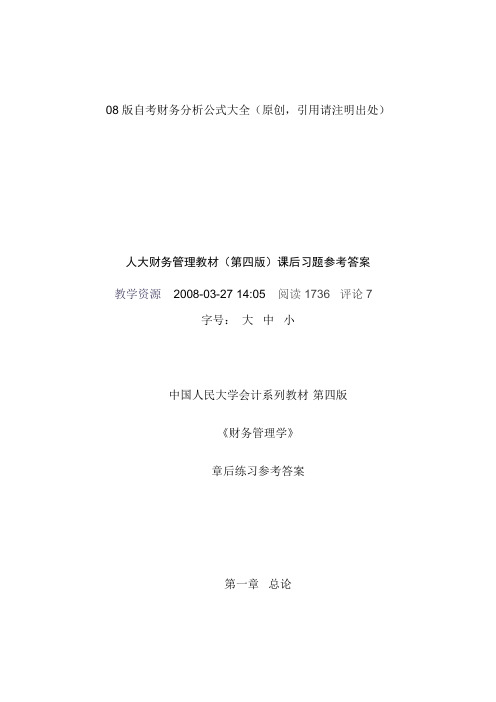
08版自考财务分析公式大全(原创,引用请注明出处)人大财务管理教材(第四版)课后习题参考答案教学资源 2008-03-27 14:05 阅读1736 评论7字号:大中小中国人民大学会计系列教材·第四版《财务管理学》章后练习参考答案第一章总论二、案例题答:(1)(一)以总产值最大化为目标缺点:1. 只讲产值,不讲效益;2. 只求数量,不求质量;3. 只抓生产,不抓销售;4. 只重投入,不重挖潜。
(二)以利润最大化为目标优点:企业追求利润最大化,就必须讲求经济核算,加强管理,改进技术,提高劳动生产率,降低产品成本。
这些措施都有利于资源的合理配置,有利于经济效益的提高。
缺点:1. 它没有考虑利润实现的时间,没有考虑资金时间价值;2. 它没能有效地考虑风险问题,这可能会使财务人员不顾风险的大小去追求最多的利润;3. 它往往会使企业财务决策带有短期行为的倾向,即只顾实现目前的最大利润,而不顾企业的长远发展。
(三)以股东财富最大化为目标优点:1. 它考虑了风险因素,因为风险的高低,会对股票价格产生重要影响;2. 它在一定程度上能够克服企业在追求利润上的短期行为,因为不仅目前的利润会影响股票价格,预期未来的利润也会对企业股票价格产生重要影响;3. 它比较容易量化,便于考核和奖惩。
缺点:1. 它只适用于上市公司,对非上市公司则很难适用;2. 它只强调股东的利益,而对企业其他关系人的利益重视不够;3. 股票价格受多种因素影响,并非都是公司所能控制的,把不可控因素引入理财目标是不合理的。
(四)以企业价值最大化为目标优点:1. 它考虑了取得报酬的时间,并用时间价值的原理进行了计量;2. 它科学地考虑了风险与报酬的关系;3. 它能克服企业在追求利润上的短期行为,因为不仅目前的利润会影响企业的价值,预期未来的利润对企业价值的影响所起的作用更大。
缺点:很难计量。
进行企业财务管理,就是要正确权衡报酬增加与风险增加的得与失,努力实现二者之间的最佳平衡,使企业价值达到最大化。
财管教材1-10章参考答案
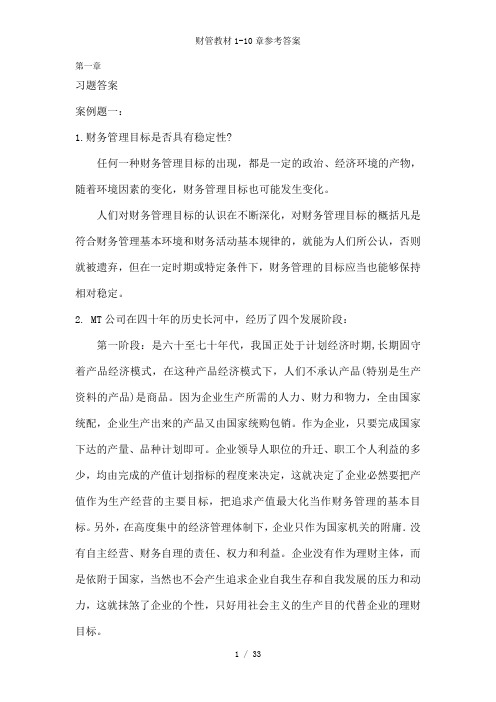
第一章习题答案案例题一:1.财务管理目标是否具有稳定性?任何一种财务管理目标的出现,都是一定的政治、经济环境的产物,随着环境因素的变化,财务管理目标也可能发生变化。
人们对财务管理目标的认识在不断深化,对财务管理目标的概括凡是符合财务管理基本环境和财务活动基本规律的,就能为人们所公认,否则就被遗弃,但在一定时期或特定条件下,财务管理的目标应当也能够保持相对稳定。
2. MT公司在四十年的历史长河中,经历了四个发展阶段:第一阶段:是六十至七十年代,我国正处于计划经济时期,长期固守着产品经济模式,在这种产品经济模式下,人们不承认产品(特别是生产资料的产品)是商品。
因为企业生产所需的人力、财力和物力,全由国家统配,企业生产出来的产品又由国家统购包销。
作为企业,只要完成国家下达的产量、品种计划即可。
企业领导人职位的升迁、职工个人利益的多少,均由完成的产值计划指标的程度来决定,这就决定了企业必然要把产值作为生产经营的主要目标,把追求产值最大化当作财务管理的基本目标。
另外,在高度集中的经济管理体制下,企业只作为国家机关的附庸.没有自主经营、财务自理的责任、权力和利益。
企业没有作为理财主体,而是依附于国家,当然也不会产生追求企业自我生存和自我发展的压力和动力,这就抹煞了企业的个性,只好用社会主义的生产目的代替企业的理财目标。
在传统的集权管理模式下,人们普遍把企业的理财目标及社会主义生产目的看作一回事,认为企业的理财目标就是为了满足整个社会日益增长的物质文化生活需要。
这种传统观点的结果,只能导致理论及实际相脱离。
社会物质文化生活的需要,是对商品使用价值的需要,它最终体现在一定数量,质量和品种的商品或劳务上,尽管它们及商品的价值有着密切联系,但使用价值的本身毕竟不就是价值,财务管理的一个最本质的特点,在于它是以价值形式(货币角度)进行的管理,显然价值的管理及使用价值的管理,不论在影响因素,管理要求,还是方法手段上都各不相同。
- 1、下载文档前请自行甄别文档内容的完整性,平台不提供额外的编辑、内容补充、找答案等附加服务。
- 2、"仅部分预览"的文档,不可在线预览部分如存在完整性等问题,可反馈申请退款(可完整预览的文档不适用该条件!)。
- 3、如文档侵犯您的权益,请联系客服反馈,我们会尽快为您处理(人工客服工作时间:9:00-18:30)。
第十章财务预算一、单项选择题1.采用公式法编制弹性成本预算的优点是()。
A.不受业务量波动影响,编制预算的工作量较小B.在一定范围内受业务量波动影响,编制预算的工作量较大C.在一定范围内受业务量波动影响,编制预算的工作量较小D.在一定范围内不受业务量波动影响,编制预算的工作量较小2.现金预算的编制基础不包括()。
A.经营决策预算B.投资决策预算C.产品成本预算D.预计资产负债表3.某期现金预算中假定出现了正值的现金收支差额,且超过额定的期末现金余额时,单纯从财务预算调剂现金余缺的角度看,该期不宜采用的措施是()。
A.偿还部分借款利息B.偿还部分借款本金C.抛售短期有价证券D.购入短期有价证券4.因素法主要适用于编制()预算。
A.固定预算B.基预算C.弹性成本预算D.弹性利润预算5.在应交税金及附加预算中不包括()。
A.预计增值税B.计入管理费用的印花税C.城市维护建设税D.营业税6.在编制弹性成本预算时,业务量的选择包括()。
A.选择业务量计量单位和业务量变动范围B.选择业务量变动范围C.选择业务量计算方法和业务量的种类D.选择业务量的种类7.关于预算的编制方法下列各项中正确的是()。
A.零基预算编制方法适用于非盈利组织编制预算时采用B.固定预算编制方法适用于产出较难辨认的服务性部门费用预算的编制C.零基预算编制方法适用于产出较难辨认的服务性部门费用预算的编制D.零基预算编制方法适用于业务量水平较为稳定的企业预算的编制8.增量预算方法的假定条件不包括()。
A.现有业务活动是企业必需的B.原有的各项开支都是合理的C.未来预算期的费用变动是在现有费用的基础上调整的结果D.所有的预算支出以零为出发点9.以下有关“某期经营现金收入”的计算公式正确的是()。
A.某期经营现金收入=该期期初应收账款余额+该期含税销售收入-该期期末应收账款余额B.某期经营现金收入=该期期末应收账款余额+该期含税销售收入-该期期初应收账款余额C.某期经营现金收入=该期含税收入×该期预计现销率D.某期经营现金收入=该期预计销售收入+该期销项税额10. ()是惟一使用实物量计量单位的预算。
A.产品成本预算B.管理费用预算C.生产预算D.直接材料预算11.某企业编制“销售预算”,已知上上期的含税销售收入为600万元, 上期的含税销售收入为800万元,预计预算期含税销售收入为1000万元,含税销售收入的20%于当期收现,60%于下期收现,20%于下期收现,假设不考虑其他因素,则本期期末应收账款的余额为()万元。
A.760B.860C.660D.96012.()编制的主要目标是通过制定最优生产经营决策和存货控制决策来合理地利用或调配企业经营活动所需要的各种资源。
A.投资决策预算B.经营决策预算C.现金预算D.生产预算13.()就其本质而言属于日常业务预算,但是由于该预算必须根据现金预算中的资金筹措及运用的相关数据来编制,因此将其纳入财务预算范畴。
A.投资决策预算B.经营决策预算C.管理费用预算D.财务费用预算14.某企业预计第四季度期初材料存量500千克,本季度生产需用材料2500千克,预计期末材料存量为100千克,材料单价为12元,材料采购货款有70%在本季度内付清,另外30%在下季度付清,该材料适用的增值税税率为17%,则企业预计资产负债表年末“应付账款”项目的金额为()元。
A.9121.2B.8845.2C.7409.3D.9243.615.某企业编制应交税金及附加预算,预算期的应交增值税为20万元,应交消费税为10万元,应交资源税为3万元,城建税及教育费附加的征收率分别为7%和3%,预交所得税20万元,计入管理费用的印花税0.1万元,则预计发生的应交税金及附加数额为()万元。
A.56B.36C.36.1D.56.1二、多项选择题1.编制预算的方法按其业务量基础的数量特征不同,可分为()两大类。
A.增量预算方法B.零基预算方法C.固定预算方法D.弹性预算方法2.固定预算编制方法的缺点有()。
A.适应性差B.可比性差C.计算量大D.可能导致保护落后3.在下列各项中,被纳入现金预算的有()。
A.缴纳税金B.经营性现金支出C.资本性现金支出D.股利与利息支出4.下列各项中属于总预算的是()。
A.现金预算B.销售预算C.投资决策预算D.预计利润表5.弹性预算编制方法的优点是()。
A.预算范围宽B.可比性强C.及时性强D.透明度高6.弹性成本预算的编制方法包括()。
A.公式法B.因素法C.列表法D.百分比法7.增量预算编制方法的缺点包括()。
A.受原有费用项目限制,可能导致保护落后B.滋长预算中的“平均主义”C.不利于企业的未来发展D.工作量大8.滚动预算的优点包括()。
A.透明度高B.及时性强C.连续性好D.完整性和稳定性突出9.现金预算的编制基础包括()。
A.销售预算B.预计利润表C.投资决策预算D.销售费用预算10.下列()是在生产预算的基础上编制的。
A.直接材料预算B.直接人工预算C.管理费用预算D.产品成本预算11.下列关于某预算期采购现金支出的计算公式中错误的是()。
A.某预算期采购现金支出=预算期初应付账款余额+该期预计采购金额-预算期末应付账款B.某预算期采购现金支出=预算期初应收账款余额+该期预计采购金额-预算期末应收账款C.某预算期采购现金支出=该期现购材料现金支出+该期支付以前期的应付账款D.某预算期采购现金支出=该期预计采购金额-预算期初应付账款余额+预算期末应付账款12.某公司2008年1-4月份预计的销售收入分别为100万元、200万元、300万元和400万元,当月销售当月收现60%,下月收现30%,再下月收现10%。
则2008年3月31日资产负债表“应收账款”项目金额和2008年3月的销售现金流入分别为()万元。
A.140B.250C.160D.24013.某公司2008年1-4月份预计的销售收入分别为100万元、200万元、300万元和400万元,每月材料采购按照下月销售收入的80%采购,采购当月付现60%,下月付现40%。
假设没有其他购买业务,则2008年3月31日资产负债表“应付账款”项目金额和2008年3月的材料采购现金流出分别为()万元。
A.148 B.288 C.128 D.218三、判断题1.生产预算是规定预算期内有关产品生产数量、产值和品种结构的一种预算。
()2.在现金预算中,必须反映在预算期内企业规划筹措用于抵补收支差额的现金,确保一定数额的现金余额,以及通过买人、卖出有价证券来调剂现金余缺等内容。
()3.生产预算是在销售预算的基础上编制的,其是日常业务预算中以价值形式反映预算期内有关产品生产数量及品种构成的一种预算。
()4.为了编制滚动预算,应将纳入预算的各项费用进一步划分为不可延缓项目和可延缓项目。
()5.当以变动成本法为基础编制制造费用预算时,可按变动性制造费用和固定性制造费用两部分内容分别编制,它们都以生产预算为基础。
()6.弹性利润预算编制的百分比法适用于单一品种经营或采用分算法处理固定成本的多品种经营的企业。
()7.经营决策预算除个别项目外,一般不纳入日常业务预算体系,同时也将影响现金预算等财务预算。
()8.财务预算具有资源分配的功能。
()9.滚动预算又称滑动预算,是指在编制预算时,将预算期与会计年度脱离,随着预算的执行不断延伸补充预算,逐期向后滚动,使预算期永远保持为一个固定期间的一种预算编制方法。
()10.增量预算与零基预算相比能够调动各部门降低费用的积极性。
()11.生产预算是预算编制的起点。
()12.根据“以销定产”原则,某期的预计生产量应当等于该期预计销售量。
()13.预计利润表是指用于总括反映企业预算期末财务状况的一种财务预算。
()14.弹性成本预算编制的列表法不能包括所有业务量条件下的费用预算,适用面较窄。
()15.现金预算中的现金支出包括经营现金支出、分配股利的支出以及缴纳税金的支出,但是不包括资本性支出。
()四、计算分析题1.某公司甲车间采用滚动预算方法编制制造费用预算。
已知2008年分季度的制造费用预算如下(其中间接材料费用忽略不计):2008年全年制造费用预算单位:元2008年度合计项目第一季度第二季度第三季度第四季度直接人工总工时(小时)1140012060123601260048420变动制造费用间接人工费用50160530645438455440213048水电与维修费用41040434164449645360174312小计912009648098880100800387360固定制造费用设备租金38600386003860038600154400管理人员工资1740017400174001740069600小计56000560005600056000224000制造费用合计147200152480154880156880611360 2008年3月31日公司在编制2008年第二季度~2009年第一季度滚动预算时,发现未来的四个季度中将出现以下情况:(1)间接人工费用预算工时分配率将上涨50%;(2)原设备租赁合同到期,公司新签订的租赁合同中设备年租金将降低20%;(3)预计直接人工总工时见“2008年第二季度~2009年第一季度制造费用预算”表。
假定水电与维修费用预算工时分配率等其他条件不变。
要求:(1)以直接人工工时为分配标准,计算下一滚动期间的如下指标:①间接人工费用预算工时分配率;②水电与维修费用预算工时分配率。
(2)根据有关资料计算下一滚动期间的如下指标:①间接人工费用总预算额;②每季度设备租金预算额。
(3)计算填列下表中用字母表示的项目:2008年第二季度~2009年第一季度制造费用预算2008年度2009年度合计项目第二季度第三季度第四季度第一季度直接人工总工时(小时)12100(略)(略)11720484202.某企业2009年1月31日的资产负债表反映的部分数据如下(单位:元)现金 35000应收账款 79200存货 160000固定资产 250000资产总计 524200补充资料如下:(1)销售收入预算:2月份100000元,3月份120000元;(2)预计销售当月可收回货款60%,其余款项可在次月收回;(3)每月购货为下月计划销售额的70%,均为当月付款;(4)预交所得税5000元;(5)每月用现金支付的其他费用为5000元,每月发生的各种非付现费用为15000元;(6)公司适用的消费税率为8%,增值税率为17%,城建税率为7%,教育费附加率为3%,假设流转税均需在当月支付,所得税率为25%。
要求:根据上述资料计算:(1)2009年2月份预算的现金期末余额。
(2)若销售毛利率为30%,2009年2月份的预计税后利润总额。
